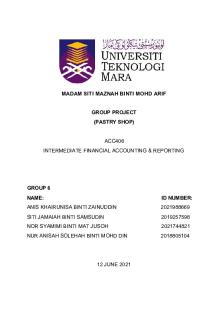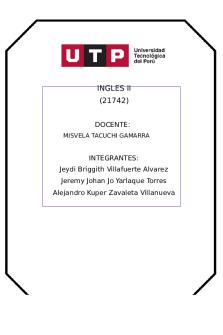Week 6 Group competiton PDF

| Title | Week 6 Group competiton |
|---|---|
| Author | Daniella Jewo |
| Course | Financing Enterprises |
| Institution | Western Sydney University |
| Pages | 4 |
| File Size | 215 KB |
| File Type | |
| Total Downloads | 74 |
| Total Views | 141 |
Summary
group multiple choice ...
Description
Week 6 Group competition solutions 1)Sales 122,800 CostofGoodsSold 104,380 AccountsReceivable 10,900 Inventory 1420 AccountsPayable 22,640 CromwellLimitedhastheinformationshownaboveonitsannualIncomeStatementandBalanceSheet (allnumbersshownareinthousands).WhatisCromwellʹscashconversioncycle? A)‐36.1days B)24.3days C)‐41.8days D)111.6days D)116.54days Answer:C Feedback: CCC
Inventory Accounts Receivable Accounts Payable Average daily COGS Average daily sales Average daily COGS 1420 10, 900 22, 640 104, 380 / 365 122, 800 / 365 104,380 / 365
4.97 days 32.40 days 79.17 days 41.8 days
2)Thedifferencebetweenafirmʹsoperatingcycleanditscashcycleis A)itsaccountsreceivabledays. B)itsinventorydays. C)itsaccountspayabledays. D)Thereisnodifferencebetweenthecashandoperatingcycles. E)Noneoftheabove. Answer:C Feedback:Thedifferencebetweenafirmʹsoperatingcycleanditscashcycleisitsaccountspayabledays.
3)Whichofthefollowingwoulddecreaseafirmʹscashconversioncycle? A)Increasetheaccountspayabledays. B)Increasetheaccountsreceivabledays. C)Increasetheinventorydays. D)Increasethecashdays. E)Noneoftheabove. Answer:A Feedback:cashconversioncycle(CCC)=InventoryDays+A/RDays–A/PDays Anincrease intheaccountspayabledayswilldecreasetheCCC. AdecreaseinaccountsreceivabledaysorinventorydayswilldecreasetheCCC. 4)Afirmoffersitscustomers3/5net25.Whatisthecostoftradecredittoacustomerwhochoosestopay onday25? A)68.4% B)32.3% C)65.5% D)74.3% E)83.8% Answer:D Feedback:$3/$97 = 0.0309, or 3.09% interest for 20 days. There are 365/20 = 18.25 20-day periods in a year. Thus, your effective annual rate is (1.0309)18.25-1 = 0.743, or 74.3% 5)CollectionfloatismadeupofallofthefollowingEXCEPT: A)availabilityfloat B)disbursementfloat C)processingfloat D)mailfloat E)Alloftheabove Answer:B Feedback:Collectionfloatismadeupofavailabilityfloat,processingfloatandmailfloat.Disbursement floatisnotapartofthecollectionfloat.Disbursementfloatistheamountoftimeittakesbeforeafirm’s paymentstoitssuppliersactuallyresultinacashoutflowforthefirm.
6)WhichofthefollowingstatementsisFALSE? A)Tradecreditis,inessence,aloanfromthesellingfirmtoitscustomer. B)Theaccountsreceivablebalancerepresentstheamountthatafirmowesitssuppliersforgoodsthatit hasreceivedbutforwhichithasnotyetpaid. C)Thetransactioncostsforobtainingtradecreditarelowerthanalternativefinancingoptions. D)Providingfinancingatbelow‐marketratesisanindirectwaytolowerpricesforonlycertain customers. E)Noneoftheabove. Answer:B Feedback:Theaccountspayablebalancerepresentstheamountthatafirmowesitssuppliersforgoods thatithasreceivedbutforwhichithasnotyetpaid. 7)SwenCorphadsalesof$154millionthisyearandanaccountsreceivableof$18million.Itscreditterms specifyʺ2/14net40.ʺOnaverage,howlongdoesittaketocollectonits sales? A)8.5days B)13days C)43days D)28days E)23days Answer:C Feedback: Accounts Receivable balance 18,000,000 Receivable days 43 days Sales / 365 154,000,000 / 365
8)Whatistheeffectiveannualcostofcredittermsof1/10net30,ifthefirmstretchestheaccountspayable to45days? A)18.03% B)8.49% C)11.05% D)10.91% E)42.15% Answer:C Feedback:Inthiscase,thefirmisstretchingits accountspayable.The firm ispaying $1 to borrow$99,so theinterestrateperperiodis $1/$99=0.0101%.However,the loanperiodisnow35 days((30–10) +(45‐ 30)).Theeffectiveannualrateis:EAR=(1.0101)365/35–1=11.05%.
9)Whichofthefollowingis/aredirectcostsassociatedwithinventory? I. Acquisitioncosts II. Carryingcosts III. Ordercosts A)IandII B)IIandIII C)Ionly D)IandIII E)I,II,andIII Answer:E Feedback:Costsofholdinginventoryare: Acquisitioncosts:arethecosts oftheinventoryitselfovertheperiodbeinganalysed (usuallyoneyear); Ordercosts:arethetotalcostsofplacinganorderovertheperiodbeinganalysed; Carryingcosts:includestoragecosts,insurance,taxes,spoilage,obsolescenceandthe opportunitycostofthefundstiedupintheinventory.
10)Whichofthefollowingisthemajorbenefittoafirmofusingjust‐in‐timeinventorymanagement? A)Itlargelyeliminatesthecarryingcostsofmaintainingalargeinventory. B)Itincreasesacquisitioncostsforplacinggoodsininventory. C)Itminimisesthetotalnumberoforders thatthefirmplaces. D)Itminimisestheriskofstock‐outs. E)Noneoftheabove. Answer:A Feedback:JITinventorymanagementiswhereafirmacquires inventorypreciselywhenneededsothat itsinventorybalanceisalwayszero,orveryclosetoit.Thiswillmainlyhaveamajoradvantageof reducingcarryingandacquisitioncostsbutwillincreasenumberofordersafirmplacesandincreasethe riskofstockouts.
...
Similar Free PDFs

Week 6 Group competiton
- 4 Pages

WEEK 6 Group Paper
- 8 Pages

Week 6 Week 6 Week 6Week 6
- 2 Pages

Group Project Account ( Group 6)
- 21 Pages

Week 6 ingles Week 6
- 2 Pages

Week 6 Assignment - Week 6
- 11 Pages

Lecture 6 - week 6
- 32 Pages

Group 6 Homework Chap14
- 11 Pages

Group 6 - Final Report
- 8 Pages

WAC 1 Group 6
- 4 Pages

Group 6 Nationwide Express
- 20 Pages

Group 6- Priceline - Assignment
- 2 Pages

Week 6 Study Notes - week 6
- 6 Pages

Literature Review Group 6
- 15 Pages
Popular Institutions
- Tinajero National High School - Annex
- Politeknik Caltex Riau
- Yokohama City University
- SGT University
- University of Al-Qadisiyah
- Divine Word College of Vigan
- Techniek College Rotterdam
- Universidade de Santiago
- Universiti Teknologi MARA Cawangan Johor Kampus Pasir Gudang
- Poltekkes Kemenkes Yogyakarta
- Baguio City National High School
- Colegio san marcos
- preparatoria uno
- Centro de Bachillerato Tecnológico Industrial y de Servicios No. 107
- Dalian Maritime University
- Quang Trung Secondary School
- Colegio Tecnológico en Informática
- Corporación Regional de Educación Superior
- Grupo CEDVA
- Dar Al Uloom University
- Centro de Estudios Preuniversitarios de la Universidad Nacional de Ingeniería
- 上智大学
- Aakash International School, Nuna Majara
- San Felipe Neri Catholic School
- Kang Chiao International School - New Taipei City
- Misamis Occidental National High School
- Institución Educativa Escuela Normal Juan Ladrilleros
- Kolehiyo ng Pantukan
- Batanes State College
- Instituto Continental
- Sekolah Menengah Kejuruan Kesehatan Kaltara (Tarakan)
- Colegio de La Inmaculada Concepcion - Cebu

